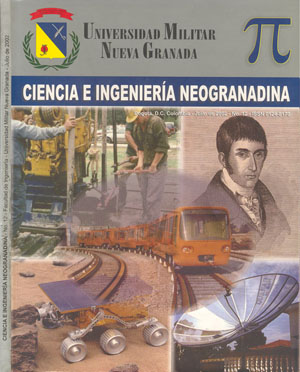Estado del arte del relleno fluido, para subbases y bases granulares (Primera parte)
Abstract
The article presents an updated compile on "Fluid Fillers", better known in technical reports as "controlled low density and low strengeth materials". The porpuse of the article is to build a basic conceptualisation as a starting point of a research process jointly managed by Universidad Militar "Nueva Granada" and Concretos Premezclados, S.A. It is the objective to optimise knowledge, design and application of material to base and sub-base in pavementes, under local conditions of technical development and available row materials. Consequently, information is given as folow; introduction; basic concepts and applications or fluid fillers; components; dosage criteria; properties in fresh and hard status; mix, transport and placing conceots; criteria on structural design of pavement, and their construction using fluid filler; Quality Control; advantages and disadvantages of proposed application.Downloads
References
ASOCRETO,"Criterios de control de calidad del concreto y relleno tluido" pp. 21-7, Bogotá.
ASOCRETO,"Especificaciones del relleno tluido", pp. 1-20, Bogotá.
ALONSO OLLlNGER, Pedro E.; "Nuevas tecnologías de pavimentación con concreto hidráulico". Bogotá, 1999.
AMERICAN CONCRETE INSTITUTE (ACI) 229R-94, "Controlled low strength materials (CLSM);reponed by ACI Committee 229, pp. 55-64,julio, 1994.
AMERICANSOCIETYFORTESTINGANO MATERIAL (ASTM 04832-95); "Standard test method for preparation and testing of controlled low strength material, CLSM test cylinders"; pp. 319-322; 1998.
AMERICANSOClETYFORTESTINGANO MATERIAL(ASTM 05971-96); "Standard practice for sampling mixed controlled low strength material"; pp. 323-324; 1998.
AMERICANSOCIETYFORTESTINGANO MATERIAL(ASTM 06023-96); "Standard test method for unit weight, yield, cement content, and air content, gravimetric, of controlled low strength material, CLSM";pp. 335-328; 1998.
AMERICANSOCIETYFORTESTlNGANO MATERIAL(ASTM 06103-97); "Standard test method for flow consistency of controlled low strength material, CLSM";pp. 332-334; 1998.
AOASKA, Wayne S.; "Controlled low strength material s"; En: Concrete International-Farmington Hills; N°4, Vol.19, ppAI-43,1997.
NORMAESPAÑOLA(UNE83-312-90), "Determinación de la densidad en el hormigón endurecido"; pp. 1-4, 1990.
BREWER,William E.; "Results of the Georgetown, Ohio, USA pavement research using controlled low strength material, controlled pavement base, CLSM"; En: Concrete in the service of mankind: proceedings of the international conference; Vol. S, pp. 253-261; 1996, London. (B1)
BREWER,William E.; "Controlled low strength material, CLSM";En:Concrete in the serviceofmankind: proceedings of the international conference; Vol. S, pp. 655-669; 1996, London. (B2)
CODEP-SOCORSALTDA.; "Fabricación de elementos para la industria de la construcción"; Representantes del aditivo Darafill, pp. 1-9,Bogotá. (Cl)
CEMEX;"Relleno fluido"; En: Revista Construcción y Tecnología W 147, Volumen 13, pp. 1-4,México. (C2) 15.
FOX,Thomas A.; "Low strength concrete and controlled low strength material"; En: Transportation research record, W 1234, pp.35-38, Washington, 1989. (Fl)
GONZÁLEZ,CarlosHernán; "Caracterización del relleno fluido usadocomo alternativa de remplazo de basesy subbases granulares"; Concretos Diamante - Samper; En:XII Simposio Colombiano sobre Ingeniería de pavimentos; pp. 17-1al 17-14; julio4 al 16, 1999, Medellín. (Gl)
HOFF,George c.; "New applications for low density concretes"; American Concrete Institute (ACI, SP-29); En: Lightweight concrete, pp.181-220, Detroit, 1971.(H1)
JOFRÉ, Carlos; "Rellenos con morteros y hormigones fluidos de baja resistencia controlada"; Revista RUTASW 67, pp. 5-21,julio-Agosto, 1998;Madrid (España).U1) 22
JARAMILLO PORTO,Diego; "Relleno Fluido. Características, propiedades, experiencias"; Asociación Colombiana de productores de concreto: ASOCRETO,En: Seminario hablemos en concreto sobre pavimentos; pp. 1-21, 1999, Bogotá. U2)
JARAMILLO PORTO,Diego; "Relleno Fluido. El nuevo material que reemplaza las basesgranulares"; ASOCRETO,pp. 64-68, Bogotá. U3)
LARSEN, Ronald L.; "Case studies demonstrating applications of controlled low strength materials"; American Concrete Institute (ACI);pAO, 1992. (L1)
MATALLANAROORíGUEZ,Ricardo; "Relleno de densidad controlada. Alternativa de cemento para rellenos de zanjas"; En: Boletín ICPCW 82, julio - diciembre,pp. 9-12, 1998, Medellín. (MI)
NTC. Proyecto de norma técnica Colombiana "Especificaciones del relleno fluido", pp. 1-8, Bogotá. (N1)
NMAI,Charles;MCNEAL,Frances;MARTIN,Dean;"Newfoaming agent for CLSM applications"; En: Concrete International Farmington Hills; W4,Vol.19,pp.44-47, 1997.(N2)
NAIK, Tarun R.;"Low strength concrete and controlled low strength material, CLSM, produced with cIass fly ash"; University of Wisconsin, Wisconsin electric powerMilwaukee, 15p. 1992. (N3)
RAMME, Bruce W.; "Progress in CLSM: continuing innovation" ; En:Concrete International-Farmington Hills; W5, Vol.19, pp.32-33, 1997. (Rl)
RIGGS, Eugene H.; KECK, Roy H.; "Specifications and use of controlled low strength material by state transportation agencies"; American Society for Testing and Materials (ASTM STP-1331); En: Design and applications of controlled low strength materials, flowable fill; pp.296-305, 1998. (R2)
RODRíGUEZ,josé; "Aplicación en vías urbanas. Hormigón ligero para relleno de zanjas": GRASE,S.A.;pp. 179-181, Madrid. (R3)
RAMIREZ GUEJIA,Élmer y SILVA,javier; "Morteros de relleno con densidad controlada para relleno de tuberías"; Universidad Militar Nueva Granada; Facultad de Ingeniería; pp. 1-17;Bogotá. (R4)
ROORÍGUEZJALlLI,Arturo; "Relleno fluido. Un material para obras de infraestructura"; En: Construcción y Tecnología N° 143, Volumen 13, pp. 36-40, Abril2000, México.(R5)
TORRENT PASCUAL,RobertoJ.; "Rellenos fluidos de resistencia
controlada"; Instituto Panamericano de Carreteras: IPC;pp. 26-30, 1998,Washington. (TI)
VICARIO, Felipe; "Los materiales de baja resistencia controlada (MBRC)";Revista HORMIGÓN N°39.Volumen 13. pp39-42.Febrero 1999.Madrid.(VI)











